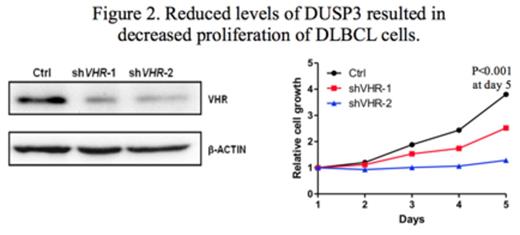Abstract
DUSP3 (also called VHR) is a member of the dual-specificity protein phosphatase family which can dephosphorylate target proteins at phosphoserine/threonine and phosphotyrosine residuals. There are evidences that DUSP3 is highly expressed in cervical and prostate cancers, and may exert its function in inhibiting apoptosis. By analyzing publicly available data on diffuse large B-cell lymphoma (DLBCL), we found that the expression levels of DUSP3 mRNA were inversely associated with overall survival (OS) in DLBCL. Patients with low levels of DUSP3 mRNA had significant longer OS than did those with high levels of DUSP3 (P=0.0002) (Figure 1). The association between the levels of DUSP3 mRNA and clinical outcome was confirmed using an independent DLBCL cohort. To decipher the role of DUSP3 in DLBCL, we used lentiviral system to stably express shRNA against DUSP3 in the DLBCL cell line, OCI-Ly01. Reduced expression of DUSP3 was associated with significantly decreased proliferation of cells as compared to the control group (P<0.001) (Figure 2). Because the standard chemotherapy for DLBCL depends largely on induction of DNA damage, we were interested in examining possible effects of DUSP3 on the DNA damage response. We found that the levels of phosphorylated H2A.X, a marker for DNA damage response, were significantly increased in cells with reduced levels of DUSP3 (P<0.01) (Figure 3). This may suggest that low levels of DUSP3 in tumor tissues render cells more vulnerable to therapy-induced DNA damage, leading to increasing efficacy of chemotherapy. More molecular and animal studies are underway to determine if DUSP3 can serve as a prognostic biomarker for DLBCL and to identify the underlying molecular mechanisms.
Disclosures:
No relevant conflicts of interest to declare.
Author notes
*
Asterisk with author names denotes non-ASH members.
© 2013 by The American Society of Hematology
2013




This feature is available to Subscribers Only
Sign In or Create an Account Close Modal